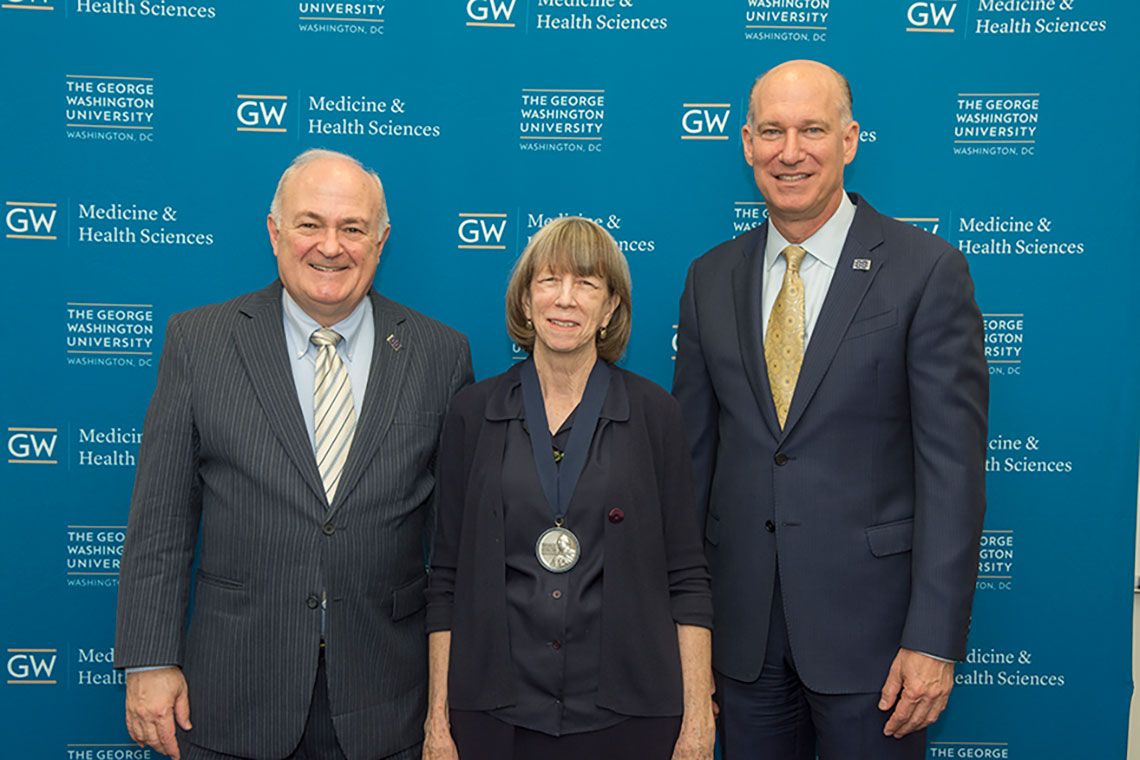
“[Dr. Miller] truly loved to teach,” recalled Patricia Latham, MD, EdD ’15, professor of pathology and medicine at the GW School of Medicine and Health Sciences (SMHS). “When I would walk down the hallway in the evening, there would be Frank Miller, with about 15 or 20 students huddled around him. What were they talking about? It wasn’t pathology; it happened to be Shakespeare.”
Latham paused at the anecdote, and the silver medal signaling her status as the inaugural Frank N. Miller, MD, Distinguished Teaching Professor shined against her black sweater. “He had such a breadth of scholarly activity and a passion for learning about everything, but this was one of the things that he truly was interested in and cared about.”
Miller, MD ’48, RESD ’50, B.S. ’43, a “Colonial through and through,” as Provost Steven Lerman termed it during the formal installation ceremony on Saturday, was a fixture at GW. The man with a passion for Shakespeare – and the diseases Shakespeare might have encountered – served the university for more than 40 years as a teacher, dean of students and curricular affairs, and chair of the Department of Pathology. He made it his mission to increase female enrollment in the medical school, and he counted numerous awards among his accomplishments. “He was the first faculty member to receive the Golden Apple Award, the school’s award for excellence in teaching,” Lerman said. “He was a beloved educator.”
His legacy continues now with the distinguished teaching professorship to pair with the eponymous Frank Miller Award, given annually to a pathology resident or fellow to recognize excellence in teaching. “I’m humbled to receive this honor because I recognize that at GW, there are many excellent physician-educators who would be deserving of this award,” Latham said. “I’m honored.”
Miller, she added, was the epitome of a “physician-educator,” the topic of her lecture following the installation. “I can’t think of someone who would more model that for us than Frank Miller,” she said. “He is a role model for the longevity that he’s had at GW and the influence he’s had on a number of different students.”
As Latham explained, medical education, of which Miller played an integral role, has experienced a gradual evolution since the release of the Flexner Report in 1910. At the time, medical schools weren’t standardized and could hardly be compared; after the report, medical education was streamlined and the template that ensued — prequalified students, an emphasis on biomedical research, an education of two years of basic science followed by two years of clinical practice — remained relatively unchanged for 100 years.
At the turn of the century, however, the Association of American Medical Colleges began reshaping the standards set by the report. In 2007, the organization unrolled a new approach to education, adjusting admission criteria and core competencies and incorporating social sciences, economics, and humanities in the curriculum. “So you can see Miller was ahead of his time with his Shakespeare and the integration of clinical medicine,” Latham said. The “sea changes,” she added, continued with the Carnegie Foundation for the Advancement of Teaching’s report, “Educating Physicians: A Call for Reform of Medical Education Residency,” which emphasized professionalism, humanism, and altruism among its four main goals.
“GW certainly wants to be on board the ship that’s going to sea,” Latham said. “However, as we set sail and move out into those sea changes, we want to be prepared.”
That preparation — the “life preserver,” she explained — is the physician-educator. “The physician-educator needs to recognize and respond to changes in medical education that are needed. That’s going to involve curricular development, it’s going to involve resource development, it needs to involve the implementation of best practices as we’ve come to know them from the literature.”
The key, she explained, involves educational theories, particularly those espoused by the Master Teacher Leadership Development Program, of which Latham is a graduate. Physician-educators need to approach teaching with both adult-learning and retention methods in mind, as adults learn differently than children. Seasoned learners have an established foundation and use past experiences to frame new information, and adults tend to better absorb information when they believe there is a perceived need. Educators should be more of a guide than a teacher and take advantage of established educational models to make the learning process more effective.
Pathology at GW, for example, has embraced an evolving curriculum, Latham said. Students now learn from visual slides, not microscopes, and small group exercises are case-based. All teaching material has been digitized, and students now receive iPads containing course information. “It’s a wonderful boon to education,” Latham said of the new technology.
The changing practice of education in pathology spurred Latham to pursue her own research, the impact of computer-assisted instruction. With the Class of 2015 as the subjects, Latham analyzed the effect of enhanced interactivity and directed learning. While the results, based on multiple-choice exam performances, did not have a direct impact, students reported higher satisfaction and higher perceived learning. “The work is not done,” Latham said.
In the meantime, Latham continues to explore developments in medical education and technology, and her efforts have served to make pathology one of students’ highest-rated subjects.
“It’s the legacy of Dr. Miller, the talent and skill of Dr. Latham and the pathology faculty that’s been an important part of the history of this medical school for decades,” said Jeffrey S. Akman, MD ’81, RESD ’85, vice president for health affairs, Walter A. Bloedorn Professor of Administration Medicine, and dean of SMHS. “It’s such an honor to have her in this endowed professorship.”


